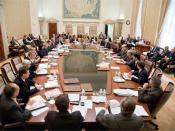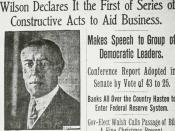Established in 1913 as per the Federal Reserve Act, The Federal Reserve System (Fed) was first designed to stabilize and regulate monetary and fiscal systems. As the national bank of the United States, the Fed is an independent component of the government. Although it regularly communicates and is advised by many parts of the economic system, the Fed operates and makes world-affecting decisions without the consent, oversight, or regulation by any other part of the government. However, the Fed does receive its appropriated power from Congress and statutes passed in the house can alter its duties. The Federal Reserve System is made up of four interconnected divisions that have there own responsibilities separate from the other parts: Board of Governors,
Federal Open Market Committee, Federal Reserve Banks, and the Reserve Bank Board of Directors.
One of the jobs of the Fed is the Beige Book. The beige book is defined as a report on recent economic conditions, published eight times each year.
The Beige Book is part of the Federal Open Market Committee's preparations for its meetings and is released two Wednesdays before each meeting. The book is a summary of economic conditions in each of the Fed's regions. The most current
April 2004 summary can be viewed by accessing the Feds homepage or going to: http://www.federalreserve.gov/fomc/beigebook/2004/20040421/default.htm. It contains information on consumer spending, tourism, manufacturing, real estate and construction, agriculture, natural resource industries, labor markets, wages and prices and banking and finance in each district. The report is primarily seen as an indicator of how the Fed might act at its upcoming meeting regarding interest rates.
Consumer spending has been the key to the United States economy since the beginning. As consumer spending increases or decreases, the interest rates fluctuate. The Consumer Expenditure Survey measures the spending habits of American...


